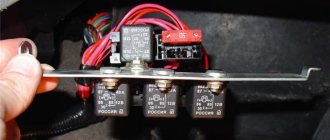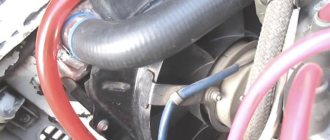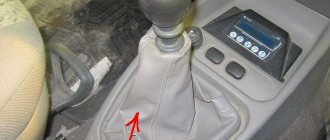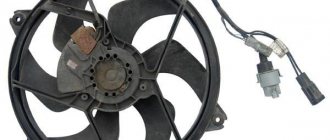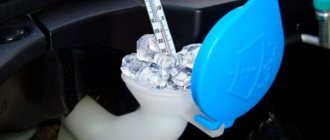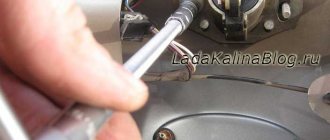Modern domestically produced cars are equipped with various controllers and sensors that ensure full operation of the car. If one of the devices fails, this can lead to incorrect operation of the nodes. From this material you can find out what the Priora and Kalina fan switch is and what malfunctions are typical for it.
If the Lada Kalina cooling fan fails, you should immediately find the cause and eliminate it. If the car “boils”, this can lead to fatal consequences. In the best case, a breakdown of the gasket, and in the worst case, a deflection of the cylinder head, which will lead to its forced replacement. So, this unit should be monitored and diagnosed regularly.
How to find the reason
Start checking with the electric motor. To do this, disconnect the electrical wires from it and connect it directly to the battery, observing the polarity. If the fan does not turn on, that is the problem. If it works, you need to look for another reason.
Check all contacts on the connectors, and then the relay and fuse. They are located in an additional mounting block, which is located to the right of the instrument panel near the lower heater air duct.
The fuse (50 A) can be checked with a tester; it is better to take a relay that is known to be working and install it in the appropriate socket. If the problem is not solved, move on.
Checking the temperature sensor. To do this, warm up the engine to operating temperature, turn it off and disconnect the sensor. It is located on top of the thermostat housing. When the sensor is disabled, the controller must independently start the fan to operate continuously.
Start the engine and wait for the fan to turn on. If the coolant temperature has reached a critical value and the fan does not turn on, you need to look for a break in the electrical wiring.
Do I need to change the fan?
If you have determined that the problem is in the fan itself, or rather in its electric motor, you can try to repair it. Most often, it stops working due to failure of the brushes, or due to problems with the rotor bearings. Less often the collector becomes unusable or a break occurs in the winding.
If the fan cannot be repaired, it must be replaced.
Under no circumstances should you drive a car with a non-functioning fan. Overheating of the engine will inevitably lead to the destruction of the rubber hoses of the cooling system, gaskets, and also threatens the failure of parts of the piston group.
Coolant temperature sensor Lada Kalina
The engine temperature sensor is one of the main components in the internal combustion engine cooling system. The unit controls the degree of engine heating, regulates the cooling order of the radiator, and opens a large antifreeze circulation circuit. If we consider the Kalina coolant temperature sensor (DTOZ), then the failure of the part will affect the order of formation of the gasoline mixture, which will lead to rapid overheating of the internal combustion engine.
Is there a need to replace the fan?
Having discovered that the problem lies in the fan or electric motor, you can try to repair this element. Mostly, on Kalina 1.6 (8 valves) the cooling fan does not turn on when the brush breaks or the rotor bearings become unusable. Less often, the problem should be looked for in the collector or winding break.
We recommend: Replacing the front engine mount of a VAZ 2114
If the device cannot be repaired, the element must be replaced. Do not attempt to drive with a broken fan. Overheating of the engine will automatically lead to rupture of hoses, rubbing of gaskets and malfunction of the pistons.
Repair or replacement
If the reason for the impeller not rotating is the electric fan, you can try to repair it. Often, repairs come down to replacing the brushes and bearings of the electric motor. But if a short circuit occurs in the stator or rotor windings, repair is impractical and the unit will have to be replaced. There is nothing else to break in the electric fan, since the design is simple.
If forced cooling does not work, the vehicle cannot be operated. Overheating of the coolant is dangerous for all components of the power unit. The rubber connecting hoses and cylinder head gasket begin to deteriorate and the valves burn out. Ultimately, extremely high temperatures will cause the pistons to expand and the cylinders to scuff, meaning a major engine overhaul will be required.
Looking for a reason
Start checking with the electric motor. To do this, disconnect the electrical wires from it and connect it directly to the battery, observing the polarity. If the fan does not turn on, that is the problem. If it works, you need to look for another reason.
Check all contacts on the connectors, and then the relay and fuse. They are located in an additional mounting block, which is located to the right of the instrument panel near the lower heater air duct.
The fuse (50 A) can be checked with a tester; it is better to take a relay that is known to be working and install it in the appropriate socket. If the problem is not solved, move on.
Checking the temperature sensor. To do this, warm up the engine to operating temperature, turn it off and disconnect the sensor. It is located on top of the thermostat housing. When the sensor is disabled, the controller must independently start the fan to operate continuously.
Start the engine and wait for the fan to turn on. If the coolant temperature has reached a critical value and the fan does not turn on, you need to look for a break in the electrical wiring.
Do I need to change the fan?
If you have determined that the problem is in the fan itself, or rather in its electric motor, you can try to repair it. Most often, it stops working due to failure of the brushes, or due to problems with the rotor bearings. Less often the collector becomes unusable or a break occurs in the winding.
If the fan cannot be repaired, it must be replaced.
Under no circumstances should you drive a car with a non-functioning fan. Overheating of the engine will inevitably lead to the destruction of the rubber hoses of the cooling system, gaskets, and also threatens the failure of parts of the piston group.
Modernization of Kalina SOD
The main problem of the Kalina cooling system is the formation of air locks. Today there are a number of effective ways to eliminate this defect. The reason lies in the design features of the SOD. The operation of the cooling system is based on the interconnected functioning of many parts. The use of the large and small circuits depends on the temperature of the antifreeze circulating through the system. The normal operation of the entire power plant depends on this.
You can modify the cooling system yourself or at a service center. Professionals rarely engage in all sorts of modifications, recommending replacing or repairing a particular component. This method may be more expensive, but not always more effective.
Classic ways of improvement
In order to solve the problem with the formation of air locks, you need to remove the expansion tank cap and start the engine. Then wait until the coolant temperature rises to the critical red zone until forced cooling by the fan comes into operation. After this, you need to press the gas pedal several times and turn off the engine.
If the method is ineffective, there is another method. To do this, you need to dismantle the engine protection, loosen the clamp and remove one of the tubes of the throttle body heating fitting. Then unscrew the cap of the expansion tank and, applying a rag, start blowing into it until antifreeze begins to flow from the removed pipe. In order to modify the standard cooling system, many car owners install a more efficient 6-hole thermostat, install a coolant filter and another heater faucet.
To increase circulation efficiency, an additional pump is often installed.
Other upgrade options
If the car is equipped with an electronic gas pedal, the hose that previously went to heat the throttle assembly is now looped into the cooling system. To prevent the formation of air pockets, an additional pipe with a smaller diameter is used, which is installed instead of the above hose. The hose for the air duct is placed near the thermostat; for this, a tee is used, mounted in the pipe fitting to the radiator. The second end of the pipe is connected to the steam removal hose near the expansion tank (you will need another tee).
The modification ensures a stable operating temperature of 90 degrees in urban conditions, and the stove begins to warm up at 50 degrees.
The next improvement method is to equip the steam outlet with a special hydraulic fence. To do this, a tube from a dropper is mounted in the steam removal hose, which is immersed in antifreeze at the bottom of the expansion tank. As it cools, the antifreeze is drawn into the outlet pipe, which prevents air from the cooling system. If desired, you can combine both methods.
Description
As you know, any Priora and Kalina have a cooling system that ensures normal engine operation and helps prevent overheating. One of the devices that allows you to cool the power unit is a fan sensor, upon the signal of which the ventilation device should turn on.
On Kalina, this controller is designed to activate the fan when the engine temperature reaches a certain point. Thanks to the fan, which must turn on based on a signal from the controller, the engine temperature will always be normal and will not exceed the permissible threshold. If the device does not work, the fan will not turn on, and the engine may overheat.
Sensor connection diagram in the cooling system
How to improve the cooling system
To prevent the question of why the Lada Kalina engine cooling fan does not turn on, you can improve the standard cooling system. There are a couple of options for solving this problem. Most often, a new thermostat is installed, which has six holes. Thanks to this, the engine temperature will be more stable.
To increase the service life of the entire system, it is worth using a special antifreeze filter. In addition, you should also install a furnace valve and an additional pump. As a result, the engine will not overheat in summer, and in winter the cabin will become warmer.
You may also be interested in: How to choose a good impact wrench for yourself
The main reasons why the radiator cooling fan does not work
Let's look at the main options and places to look for faults:
- Thermostat.
Thermostat removed from Lada Kalina
If it fails, this is the reason why the cooling fan does not work correctly . To diagnose this malfunction, you should touch the lower pipe. If it is cold, then the thermostat is dead. Many Kalina car owners are accustomed to this phenomenon, since it often breaks down, and they carry a spare one with them.
- If it's not the thermostat, then the next step is the fuses. You need to make sure that they are working and all controllers too. The easiest way is to test them using a tester or ohmmeter. The fuse diagram is here.
The relay box with the fan fuse is located under the instrument panel console, next to the controller. The fan fuse has a capacity of 50A, it is number 3 . Fan relay number 1 .
Relay and fuse box
If the fuse is alive, then you will have to remove the additional fan control unit. To do this, it is worth moving the warm air duct and using a 10 mm wrench to unscrew the fastenings of the unit. Now you can get it freely. It has two relays that are responsible for turning on the fan and for high speeds. Let's diagnose both.
- Now, we can move on to the darkest option - we climb under the hood and “ring” the contact wires of the fan itself. Of course, there may be a break or break in the wire, but there is nothing worse than a burnt winding inside the fan. Most likely the fan in this case will need to be replaced.
- Another reason for the fan not turning on may be a broken thermostat sensor . In order for the fan to start in emergency mode, you will have to remove the connectors from it. You can check the sensor by removing the thermostat and placing it in a pan of hot water; the thermostat should open.
- The last reason why the fan may not work is a break in the switching circuit itself.
Electrical circuit diagram of the cooling fan
We recommend: Removing the steering wheel on a VAZ-2107: step-by-step instructions with photos
Let's sum it up
If a cooling circuit fan in a Lada Kalina fails to operate, then such a malfunction can be corrected independently. We have reviewed almost the entire list of reasons that could cause a malfunction, and also provided an algorithm for replacing the unit. Use our material as instructions for action and tend to periodically inspect the cooling system; a switching diagram can also help you. This will minimize the risk of unpleasant circumstances occurring on the road.
Replacing the cooling fan Lada Kalina
To replace the cooling fan, it is not necessary to go to a service station. You can do this without much difficulty on your own.
Required tools:
- head with ratchet or socket wrench 10;
- spanner or open-end wrench 8;
- screwdriver with Phillips bit;
- pliers.
Work order
- Place the car on a level surface.
- Raise the hood, disconnect the ground wire from the battery.
- Using a 10mm wrench, unscrew the two air filter mounting bolts.
- Disconnect the mass air flow sensor connector by pressing the latch.
- Disconnect the purge valve connector located on the air filter housing.
- Using a screwdriver, unscrew the bolt of the air duct fixation clamp and remove the corrugation.
- Unscrew the 4 screws securing the air filter cover.
- Remove the cover and remove the filter element.
- Using a size 8 wrench, unscrew the nut securing the air intake and remove it.
- Using a size 10 wrench, unscrew the two nuts securing the fan casing on the right in the direction of travel of the car, and then with a size 8 wrench, unscrew the two nuts on the left.
- Disconnect the fan power connector.
- Carefully, so as not to damage the radiator fins, remove the fan along with the housing.
- Using a 10mm wrench, unscrew the 3 bolts securing the electric motor and remove it from the housing.
- Install a new electric motor with impeller in its place.
- Screw the casing assembly with the fan to the radiator.
- Connect its connector.
- Carry out the rest of the installation work in reverse order.
The price of a cooling fan and the cost of replacing it
Prices for a cooling fan for the Lada Kalina (electric motor with impeller) vary between 1500-2500 rubles. Replacing this unit at a service station will cost 300-400 rubles.
When buying a new fan, pay attention to its manufacturer and catalog number. This part may have the following numbers:
- 1118-1308008;
- 1118-1300025;
- 21230-1300025-00;
- 2123-1300025 (with two engines for Kalina 2123);
- MOD285 (BM brand);
- BMMOD285 (Pilenga brand).
How to replace a fan
Having understood exactly why the cooling fan of the Lada Kalina does not work, you should replace the faulty element. With the proper skills and dexterity, you can perform the repair yourself. The tools you need to prepare are pliers, a screwdriver, wrenches 8 and 10.
First, we place the vehicle on a level surface. Then we lift the hood and disconnect the system from the battery. Using a wrench, disconnect the air filter mounts. Next, you need to disable the mass air flow sensor (just press the latch) and the purge valve, which is located on the air filter housing. Unscrew the clamp bolt and remove the corrugation.
Remove the air filter cover, remove the filter element, and dismantle the air intake. Then we proceed to attach the fan casing and disconnect the power supply to the fan. Having done everything correctly, you can dismantle the fan. We remove the electric motor and then replace it with a new element. Then we put everything back together.
We recommend: How to properly lubricate a starter with your own hands?
Finally, it is worth checking the functionality of the device. We start the engine and then warm it up for 3-5 minutes. The fan should turn on during this time. There is no need to turn off the car as soon as the fan starts spinning - you should wait until the device turns off automatically.
How to dismantle
Many drivers are confused where the temperature sensor is located in the system, which provides information to the ECU, and where the instrument cluster is. In Kalina, the first controller is embedded in the thermostat, which is located on the coolant outlet pipe from the engine. The transmitting sensor is located nearby; you can find it using a thin wire.
All work on removing and installing parts is carried out with the engine turned off and the negative terminal of the battery disconnected. Dismantling order step by step:
- Loosen the screw securing the air hose coupling to the air filter housing. This will allow you to get to the instrument sensor. If necessary, remove the air filter housing for good access to the sensors.
- Remove the screen or engine cover, using force, remove the cover from the latches.
- Drain the coolant from the radiator. On Kalina, antifreeze or antifreeze is used. To do this, the fluid needs to be cooled, but experienced drivers replace it without draining the antifreeze. In this case, all replacement work will need to be carried out quickly and accurately. Therefore, if the sensor is changed for the first time, it is better to drain the coolant so that an air lock does not form in the system.
- Disconnect the wire block.
- Using a socket head or a 19 mm wrench, unscrew the sensor from its seat. If the coolant is not drained, antifreeze will flow out of the hole. Therefore, experienced drivers who are too lazy to drain it immediately clamp the hole with their finger and insert a new one.
Installation of the elements is carried out in the reverse order - the sensor is inserted into the hole, screwed in, connected to the wire block, and antifreeze is poured. The functionality of the system is checked after connecting the battery.
What if the fan completely stopped working?
To determine the cause of such a malfunction, you first need to check the condition of the fuse in the electrical circuit. It can be found on the side console, near the passenger seat. It is hidden under the deflector cover. By unscrewing the screw, the cover can be easily removed and the fuse will be available for examination.
To remove the entire safety block and connected relays, the mount must be released. You can't do this without wrenches. You need to remove the unit carefully without haste, as you can damage the wires that are connected to it. Only the single fuse of the unit is responsible for the operation of the fan.
If the fuse is intact, it is necessary to check the operation of the relay that powers the fan motor. There are two such relays installed. The left one turns on low fan speed. And the one located on the right is responsible for the high speed of its operation.
Another problem that relates to the cooling fan relay is that the cooling fan continues to operate when the ignition is turned off. This may drain the battery. “Kalina” then simply won’t start. The main reason is sticking contacts. The block is exposed to antifreeze leaking from the radiator installed above the stove.
When the relays and fuses are working properly, you need to check the operation of the temperature sensor. It is he who orders the fan to start working. This sensor is located on the right side of the radiator tank.
To check its functionality, you need to remove the plug connector, take a jumper, and use it to short-circuit the connector terminals. The fan turning on indicates that the sensor is in good condition. If the fan does not react at all, then before changing the sensor, you need to check the functionality of the fan motor. To do this, the electric motor terminals must be connected to the battery contacts. The engine should start working. In case of failure, you will have to install a new electric motor.
Causes and symptoms of fan malfunctions
To understand that the electric fan is faulty, you don’t need complex diagnostics - any car enthusiast can do it. You should start the engine and let it idle until the coolant temperature reaches a critical temperature. You can monitor the process using the temperature sensor on the instrument panel. When the arrow is close to the red zone, the sensor should give a signal to the controller, which will start the fan. You can recognize this by the characteristic noise coming from the engine compartment. If the indicator shows a critical temperature, and the fan does not start working, then there is a malfunction that needs to be corrected immediately. The fan may not work for a number of reasons:
- The electric motor is faulty. In this case, it will not rotate the impeller. Typically, on VAZ cars, the electric motor rarely fails. To check its functionality, you will need to connect it to the battery directly. To do this, you need to take two wires and connect their ends to the battery terminals and the electric fan wire block. If in this case the impeller does not rotate, then there is a malfunction of the electric motor. This part rarely requires repair. You will need to remove the assembly and replace the electric motor. The work is simple and can be done even outdoors with your own hands with a minimal set of tools.
- The temperature sensor is faulty. If the sensor fails, it cannot track the increase in coolant temperature; accordingly, the controller receives incorrect readings and the fan does not turn on when needed. To diagnose this problem, you will need to disconnect the wire plug from the sensor and short the two terminals together. If the fan operates and the impeller starts to rotate, the sensor is faulty and needs to be replaced. The procedure is complicated by the need to drain the coolant, but it is not so complicated that this problem should be addressed to a service center.
- No tension. The most common malfunction associated with an electric fan is a break in the electrical circuit in one of the sections and a lack of voltage. For diagnostics, you need to “ring” the electrical wiring and check the fuses; to work, you will need a tester (multimeter). If you do not have the skills to use a multimeter, it is advisable to contact an auto electrician.
A problem with the electric fan is also possible in another situation, when the impeller rotates constantly and the electric motor does not turn off. The electric fan may always work or start working too early, when the coolant temperature has not yet even reached operating parameters.
- The relay contacts are stuck. Sometimes situations may arise when the fan relay contacts are constantly in the “on” position, which is why the fan will start immediately after the engine starts. The relay should be replaced and tested for functionality.
- The temperature sensor is faulty. The sensor transmits elevated temperature readings to the electronic engine control unit, which causes the controller to send a signal to turn on forced cooling. Will need replacement.
- Thermostat malfunction. The cooling fan on Kalina is not equipped with an auxiliary temperature monitoring sensor. This means that only average indicators are taken into account. If the thermostat valve is stuck in the closed position, the coolant circulates only through the small circuit and cannot flow into the large circuit. The antifreeze heats up quickly and the electric fan starts to turn on very often. In this case, the liquid does not pass into a large circle, that is, there is no hot antifreeze in the radiator, the fan cools the cold radiator, and the liquid continues to heat up, which leads to overheating of the engine. The thermostat may also jam in the middle position when the valve does not open completely. This also leads to ineffective cooling - the fan will run constantly due to the fact that the antifreeze cannot cool enough. In these cases, you will need to replace the faulty thermostat; this is easy to do yourself. If you need to save time, you can entrust this procedure to the service. Replacing cooling system components is not a complex task and can easily be done independently. An exception is the replacement of the water pump, since it has a single drive with the gas distribution mechanism.
Constant operation of an electric fan is not as bad as if it did not work at all, unless the problem is related to a faulty thermostat, as it can lead to overheating and failure of the power plant.
Engine cooling system: SOD Kalina and modification
Let us note right away that correct modification begins with the fact that it is necessary to slightly change the distribution of antifreeze flows in the cooling system of the VAZ-1118 Kalina. This will reduce the intensity of airing due to the jamming of the compensation valve of the expansion tank cap.
Please note that simply removing the valve from the cover, as many suggest, is strongly not recommended, as the engine may overheat. It would be better to lower the fan temperature in the firmware to 98 degrees.
Another method is to embed an adapter into the radiator inlet pipe where the TM-108 sensor from a VAZ 2109 is installed, which is also not recommended. Although these methods are often discussed on specialized forums, they are offered by some car owners and garage specialists, experienced craftsmen still advise going the other way. A more correct method involves upgrading the cooling system on Kalina with both a mechanical throttle and an electronic one.
In general terms, you need to do the following:
- you need to drain the coolant, and then put a plug in the pipe that connects the large cooling circle and the expansion tank;
- then the free fitting is connected to the lower heater hose through a tee. The VAZ 2110 tee is suitable for these purposes;
- the next step is to plug the distant hose (thin outlet hose) designed to heat the throttle assembly;
- then the released fitting must be connected through a suitable tube to the expansion tank. To do this, you need to cut another “nipple” into the upper cavity. You can also connect via a tee to connect to a thin input;
- then you should fill in the coolant, a little higher than that, start the engine and warm up the unit until the fan turns on. The final stage will be to de-air the system and adjust the level of antifreeze or antifreeze.
This modernization allows for steam removal through a small circle, and aired liquid can be collected at the highest point of the cooling system. By the way, as for the version with an electronic gas pedal, in this case the thin thermostat fitting is connected to the top of the expansion tank.
Again, you can connect through a tee or drill in an additional fitting. In this case, the standard tube from the thermostat must be plugged. Next, you need to disconnect and plug the lower hose of the expansion tank of the cooling system, then connect an additional line from the tee. In turn, the tee cuts into the heater return.
The result of such actions will be active de-airing of the cooling system, the stove will heat normally at different speeds, and the engine temperature will always remain at a normal level, regardless of the mode and load on the engine.
At the same time, it is quite obvious that if the thermostat on the Lada Kalina is working properly, it is not necessary to change it. In other words, it is not the cause of overheating or a cold stove. In turn, a more comprehensive improvement of the cooling system of the Lada Kalina allows us to solve a number of problems.
